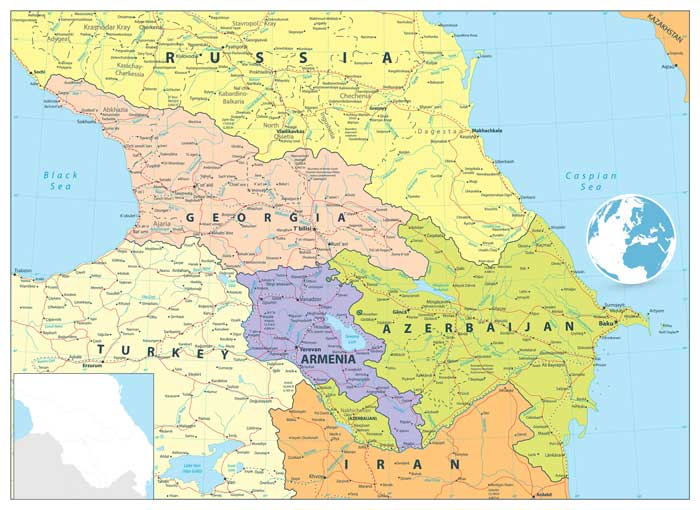AIIB Eyes Azerbaijan Infrastructure Financing
The Middle Corridor and the INSTC from the East Caucasus to Middle and East Asia look attractive investment opportunities
The Middle Corridor and INSTC supply chains between the East Caucasus and the Middle and Far East are the focus of attention from the Asian Infrastructure Investment Bank (AIIB), according to Konstantin Limitovskiy, Vice President of the banks Investment Operations. Azerbaijan’s railway sector, shipping sector and other infrastructure
sectors are of interest to the bank, he has stated in an interview.
Limitovskiy said that Azerbaijan has been a respected founding member and a client of AIIB since 2016, with the first project both sides did together being the Trans Anatolian Natural Gas Pipeline (TANAP), for which Azerbaijan
received US$600 million investment from the bank. AIIB also supported Azerbaijan with a US$100 million investment during the pandemic to aid in COVID recovery efforts.
“I am here with a mission to identify new projects for collaboration. Today we’re discussing possibility in the second phase of TANAP. The Ministry of Economy is our main counterpart ministry in the government. Together, we’ve identified a potential pipeline of very interesting projects in railways sector, shipping sector and in variety of infrastructuresectors,” he said.
Limitovskiy highlighted the significance of the Caucasus region for AIIB particularly because of its strategic location, connecting Europe and Asia.
“The South Caucasus, especially, is a very important region for us to promote regional cooperation. It is one of the priorities for the bank. The reason is that it is a key bridge connecting Europe and Asia, Europe and Middle East. So we really believe that this region is going to play more important role in the both regional and global logistics,” he said.

Limitovskiy emphasized that the bank aims to foster development in the Asian region by financing sustainable and forward-looking infrastructure projects and highlighted the importance of attracting private sector capital to infrastructure investments.
“To date, the bank’s portfolio across all the regions is that around 75-80% of the total is in sovereign lending and investments, and the private sector is only 20-25%. It is our target to make sure that by 2030, 50% of our investments are the private sector investments, or non-sovereign investments,” he said.
He also mentioned that the bank finances energy-related projects in various countries.
“We are financing the solar and wind power plants projects. Renewable energy sources financing is one of the key areas in the private sector. For instance, we have one of the first wind farms in Kazakhstan – Zhanatas. We finance ‘Waste to Energy’ projects. In Türkiye, we have the modern energy efficient facilities, and 1,500-megawatt gas-fired project in Uzbekistan, in Sirdarya region. There are lots of interesting projects that we are looking for in private sector partnership. To qualify for our financing, the project should align with our mission and mandate. We are looking for green infrastructure, infrastructure supporting the critical needs of the people. We look specifically and proactively for the connectivity infrastructure,” said Limitovskiy.
According to him, connectivity should not be only transport connectivity; it can also be digital connectivity or energy connectivity.
“We would like to see private sector capital in co-investment with our operations. These are the main highlights of the criteria. Of course, the projects should bring the economic value to the country and to the sponsors. So, they should be economically available and financially sustainable,” he added.
“Normally, AIIB can inform the client whether it can finance the project or not within the period of one week, if all the information is ready. The bank has a lot of clients. The goal of AIIB is to identify the company with same approach, same mentality and help them to prepare the projects and implement them.
“The key principle is that we need to see the projects that are contributing to decarbonization in the country, fostering cooperation in the region and using the modern technology which would last for a long period of time and have the possibility to mobilize private sector capital,” he said.
The Asian Infrastructure Investment Bank is one of the youngest development banks. The bank was originally established in 2016 by 57 member countries. Today, the bank is owned by 106 shareholders, and is primarily dedicated to infrastructure investments, with a specific focus on the Asian market.
The key objective of the bank is to foster the developments in the Asian region through the financing of sustainable infrastructure.
AIIB’s mission, “Infrastructure for Tomorrow”, focuses on investments aligned with four priorities: Green Infrastructure, Connectivity and Regional Cooperation, Technology-Enabled Infrastructure, and Private Capital Mobilization.
Related Reading





